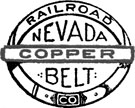Mason
Mason was established in 1906 following development of copper mines nearby. The town grew slowly, gaining a post office in 1908, but its real boost came in 1910 with the arrival of the Nevada Copper Belt Railroad. In May of that year, a large celebration was held to mark the beginning of service. Mason was chosen as the location of the NCB's offices, shops, roundhouse, and a passenger depot. The town also served as the shipping point for the area's crops and livestock as well as a residential area for mine officials. In 1912, a tramway was also completed to connect nearby mines (including the Bluestone) to the railway.
By 1914, Mason had grown to a respectable town of near 1000, with a bank, brick hotel, stores, saloons, a fine school building, two churches, hospital, and other facilities. The town also boasted electric lights and a water system, and for many years rivaled nearby Yerington. About 1916, the Bluestone Mining & Smelting Company laid a 2½ mile spur to its mine. Mason thrived for a couple more years, but after World War I began to slowly decline. The rail to the Bluestone Mine was eventually abandoned in 1929 due to a decline in ore, and by 1940 the school was closed and dismantled. In 1947, the NCB was abandoned and its facilities were removed, and Mason's population dwindled. Today, the town is a small bedroom community to nearby Yerington, and a small population remains. Only a few remnants tell of Mason's once prosperous life.



























